Video: What are the top 20 causes of construction claims and disputes around the world?
14 November 2023
Changes in scope are the number one cause of claims or disputes in construction projects around the world.
That’s according to new analysis of 1,800 high-value projects in 106 countries with a combined capital expenditure value (CAPEX) of $2.247 trillion.
The latest edition of the CRUX Insight report, Forewarned is Forearmed, has ranked the top 20 causes of claims and disputes on projects around the world (click on the video above to see the full top 20).
Scope changes were not the main cause of disputes and claims in all regions, however.
Design issues dominated the list in some areas of the world, such as in Europe, where incorrect designs were the main cause of claims and disputes.
The report said, “Our analysis also makes it increasingly evident how design failures drive project distress directly and in conjunction with changing scope.”
It highlighted the fact that three design-centric factors – incorrect, late, or incomplete design information – were clustered within the global ranking’s top five causes, with the three of them combined afflicting a greater proportion of projects overall (44.8%) than scope changes alone (38.8%).
It said, “Our local consultants observed that design immaturity more than negated any apparent gains in the early stages of fast-tracked programmes.
“Construction’s cruel conundrum is that the level of design maturity is more controllable than many other triggers for claims and disputes.”
It added there was anecdotal evidence that extra time taken to review and mature designs during the pandemic helped to improve constructability.
“A comparison of design failure rates before and after the hiatus shows a global drop of 12 percentage points (from 47.6% to 35.5%), widening to 14 points in the Middle East and nearly 18 in Europe, where incorrect design was already the leading cause of claims and disputes,” the report said.
Causes of claims and disputes by region:
Africa
The factors driving claims and disputes in Africa were more distinctive and the economic and political instabilities more acute than in other regions, according to the report. Despite severe energy shortages on the continent, it was power projects in Africa that showed a “more damaging pattern of claims and disputes” than the rest of the world.
Rather than changes in scope (as in many other regions), it was late or restricted access to sites which topped the ranking in Africa. The report found that multi-disciplinary megaprojects were prone to flow-down delays as contractors overlap, with poor management of subcontractors and interfaces in evidence on nearly a quarter of projects (23.9%).
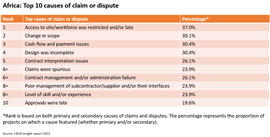
The Americas
In the Americas, it was changes in scope and under-developed designs that were the top causes of claims and disputes. Deficiencies in workmanship also figures high in the list, indicating a lack of skilled workers in the sector.
The report noted that it was becoming “more common” for projects to go to tender with incomplete front-end engineering design, while clients are putting contractors under pressure to work faster and shortening schedules. Contractors, meanwhile, may fail to communicate the full extent of the implications due to concerns of souring relations with the client.
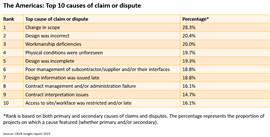
Asia
Projects in Asia were little different to other areas in the sense that changes in scope were again the top cause of claims and disputes.
Where the region differs to some other areas is that most major projects are instigated by governments and their requirements can often be less clear than those of private companies, according to the report. It added, “With some exceptions, procurement strategies tend to be less advanced than in other regions such as Europe and the Americas. Other causation factors are linked, such as the absence of early contractor involvement, which can give rise to design immaturity (in turn leading to later changes in scope).
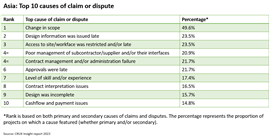
Europe
Unlike in most other regions, design issues topped the list of causes in Europe.
The report explained that the design market in the region is under pressure, with design teams squeezed on budgets and programmes. Design costs in Europe, reflecting professional pay rates, tend to be higher.
It added, “More universal is the haste of employers to start construction (for understandable but risk-laden reasons), undervaluing planning and preparation.”
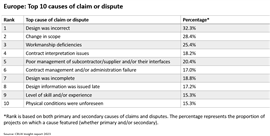
Middle East
Projects in the Middle East suffered the highest share of scope changes of any region, while failure to complete designs on time was another major cause of disputes.
The report said, “Many of the projects analysed are first-of-a-kind and complex, often located in challenging locations, which can make it more difficult to attract and retain experienced staff. But the top-ranking causes of claims and disputes in the region tend to stem for timescales that are unrealistic.”
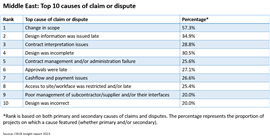
Oceania
The prevalence of changes in scope as the primary driver of claims and disputes was particularly pronounced in Oceania, cited by more than half of projects.
The report said the reasons for this are universal – projects go to market without being scoped properly first. The results may also have been accentuated by the fact that the proportion of government-funded transportation infrastructure projects in the latest analysis was high.
“Given the high political capital invested in landmark schemes, they tend to be backed and announced before detailed scoping, design and costings are fully conceived,” the report said.
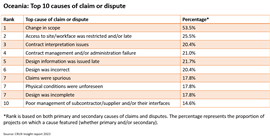
Other findings in the report included:
- At a project level, claimed costs around the world averaged out at more than a third of committed project CAPEX (33.6%).
- Programmes typically facing an overrun approaching 16 months equivalent to two thirds of the planned schedule (67.1%).
- Offshore wind farms were more likely to be thrown off by a change in scope than other renewable projects and those in non-energy sectors.
- Changes in scope were a primary or secondary cause in 57.1% of rail and transit project worldwide. Design failures were also prominent, although often symptoms of other failures like political commitments to delivery dates and provisional costings.
“In a period when the cost of capital has risen significantly, and its supply is more constrained in most markets, the impacts of project distress are all the more chastening,” said Renny Borhan, partner and chief executive of claims advisory and dispute resolution company HKA, which produces the report.
“The total value of the sums in dispute exceeded $91.3 billion. Collectively, extensions of time sought by contractors would stretch beyond 876 years.”
STAY CONNECTED



Receive the information you need when you need it through our world-leading magazines, newsletters and daily briefings.
CONNECT WITH THE TEAM








